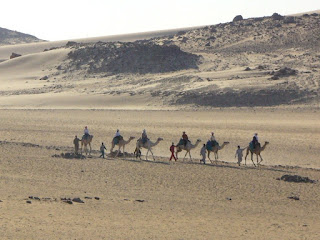I was surprised to discover that Aswan actually has two dams. The oldest of these, the Aswan Low Dam, or Old Aswan Dam as it's commonly known, was completed by the British in 1902. At the time it was the world's largest masonry dam. Today, it's the city's primary river crossing. However, an impressive new stay cable bridge recently opened upstream as a second crossing.
The high dam sits 6km upstream from the old dam. Everything about this structure is big!. It's 3.8km long, 111 metres high, and incredibly, it's made entirely from rock and clay. The base of the dam is an astounding 980 metres wide, while the crest is a modest 40 metres. It's currently the world's largest embankment dam.
Our tour group then crossed to the West bank of the Nile, hired camels, and trekked across the desert to the abandoned monastery of St Simeon. The decaying ruins were a photographer's paradise, made all the more dramatic by late afternoon shadows. Without a doubt, it was a memorable experience with plenty of iconic desert imagery.
On our last full day in Aswan, we awoke at 2:30am to join a convoy of 50 buses traveling to Abu Simbel, about 280km south. Tourists now travel in armed convoys as a result of a terrorist attack that occurred at Luxor in 1997. Then once there, machine gun touting soldiers keep watch as you explore the temple’s environs. I'm happy to report that our early morning transfer passed without incident. Instead, most of us passed the time catching up on lost sleep.
Abu Simbel was phenomenal. Ramses II certainly knew how to commission a decent temple. The location is everything you imagine it to be. To think that such a structure was taken apart and moved to higher ground in the 1960s is equally amazing. The only downside? Traveling in convey meant the serenity of its location on the shores of Lake Nasser was somewhat diminished by the crowd.
I had to metaphorically pinch myself more than once. I couldn’t believe that I was seeing this magnificent complex with my own eyes. I recall first learning about Abu Simbel from a cover story published in National Geographic magazine in May 1969. However, at the time the only reason I had a copy of this particular magazine was thanks to article about Apollo 8.
From Aswan, it was back to Cairo on another sleeper train. The complementary breakfast wasn't so memorable. There are only so many pieces of stale bread one can endure! I'll leave you with a few parting images of our journey up the Nile. Far more memorable than the train!































No comments:
Post a Comment